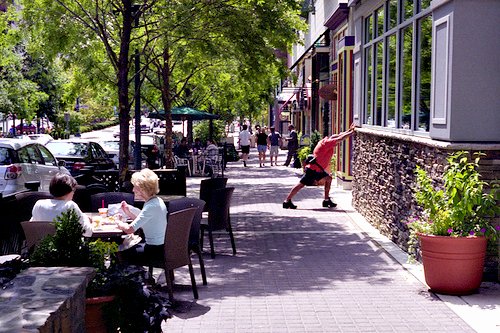Chris Leinberger on the transformation of our built environment

Posted April 17, 2009 at 4:30PM
I'm on the road today so, rather than generate a new post of my own, I'm going to point you to one that I really like. In particular, The Infrastructurist is running a terrific interview with Chris Leinberger, a developer and market analyst who has become one of America's best voices in support of walkable, smart growth. Here's some of it:
"For a half century, it's been easy to mock suburbia for being too comfortable, white-bread and conformist. That's all changed in the last 18 months as many suburbs have abruptly taken on a sense of tragedy and desperation . . .
"One man who foresaw all the ugliness is Christopher Leinberger. The Brookings Institute fellow and distinguished scholar of the suburban living arrangement has decades of experience in real estate development and urban planning. The meme of doomed suburbs went mainstream with his cover story for the Atlantic magazine last March, "The Next Slum?" The problem, he says, goes much deeper than the foreclosure crisis. It's part of a painful societal adjustment that will take a generation or more to work through . . .
"In this conversation he analyzes the roots of suburbia's current plight and explains how three straightforward adjustments to infrastructure can save a community.
"The suburbs are really suffering. What's the short-form diagnosis?
Americans are undergoing a fundamental shift in where they want live, work, and play. So this is not just a normal cyclical downturn. We've structurally overbuilt retail, office, and housing, and we've done so in the wrong places."Last year people were talking about high energy prices as the one of the prime causes of suburban collapse. But gas is back under $2 a gallon.
Energy prices have nothing to do with it. I said that at the time. They can accelerate the process, but what drives it is the shift in consumer preferences. Gen Xers and Millennials want a lifestyle closer to Friends and Seinfeld (that is, walkable and urban) than to Tony Soprano (low density and suburban). It's not that nobody wants Tony Soprano. About 50 percent of Americans actually do want that configuration. But if we've built 80 percent of our housing that way, that's the definition of oversupply. The other 50 percent of Americans want walkable urban arrangements and yet that's just 20 percent of the housing stock. That's called pent-up demand. So the market is just responding."Give us some hope. How can a suburb save itself?
It can adapt. The Washington DC metro area is a useful model. A year ago I came out with a survey for Brookings looking at walkable urban places in the top 30 metro regions. DC was at the top on a per capita basis."So what can DC teach us as an example?
What we're learning about the DC area is that there are 30 of these walkable communities here. I'm only talking about regionally significant places, not individual neighborhoods. So, for instance, downtown DC, Reston, Bethesda and so on. Of these places, 90 percent are on the metro system and most of the rest will be linked into it in the next five years. So that's a pretty obvious correlation right there. But most of these walkable places are in the suburbs."What's the lesson?
This structural trend is about the transformation of the suburbs into something else. I've been doing some research looking at the price premiums on a per-square-foot basis for walkable communities. They get a price premium between 40 and 200 percent. I've also been looking at what I call the "penumbra." A walkable place is typically 50 to 500 acres in size. The penumbra, that area around it, can be even bigger."Almost like micro suburbs.
Yes. These places are still suburban but they are within walking distance of the walkable places. This "penumbra" is seeing premiums of 20 to 80 percent over the rest of the market . . ."
The interview has much more, and it only gets better. Go here for the full story.

